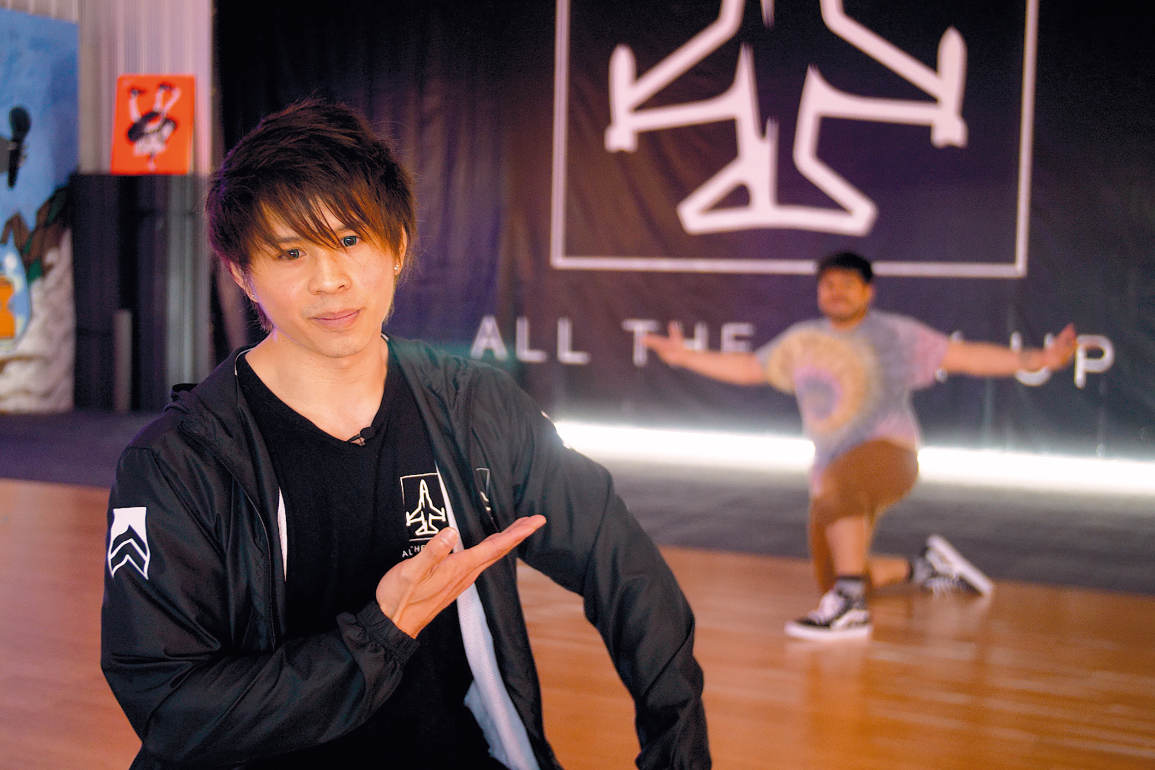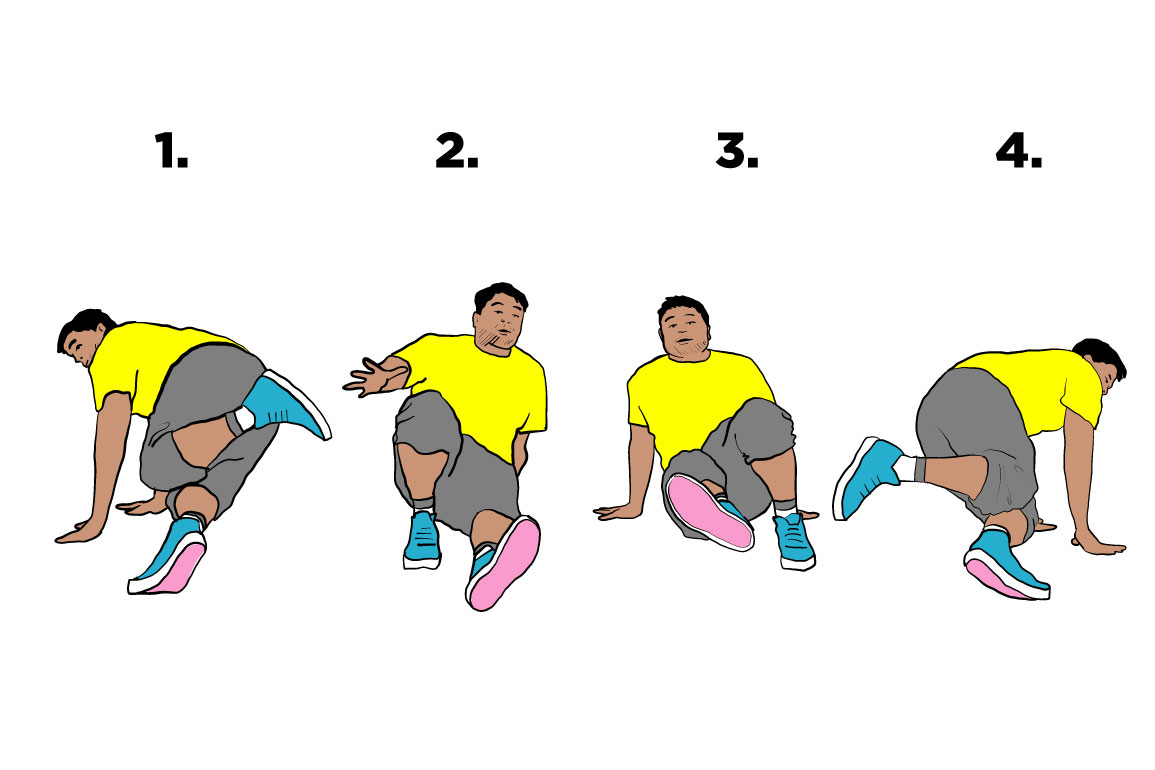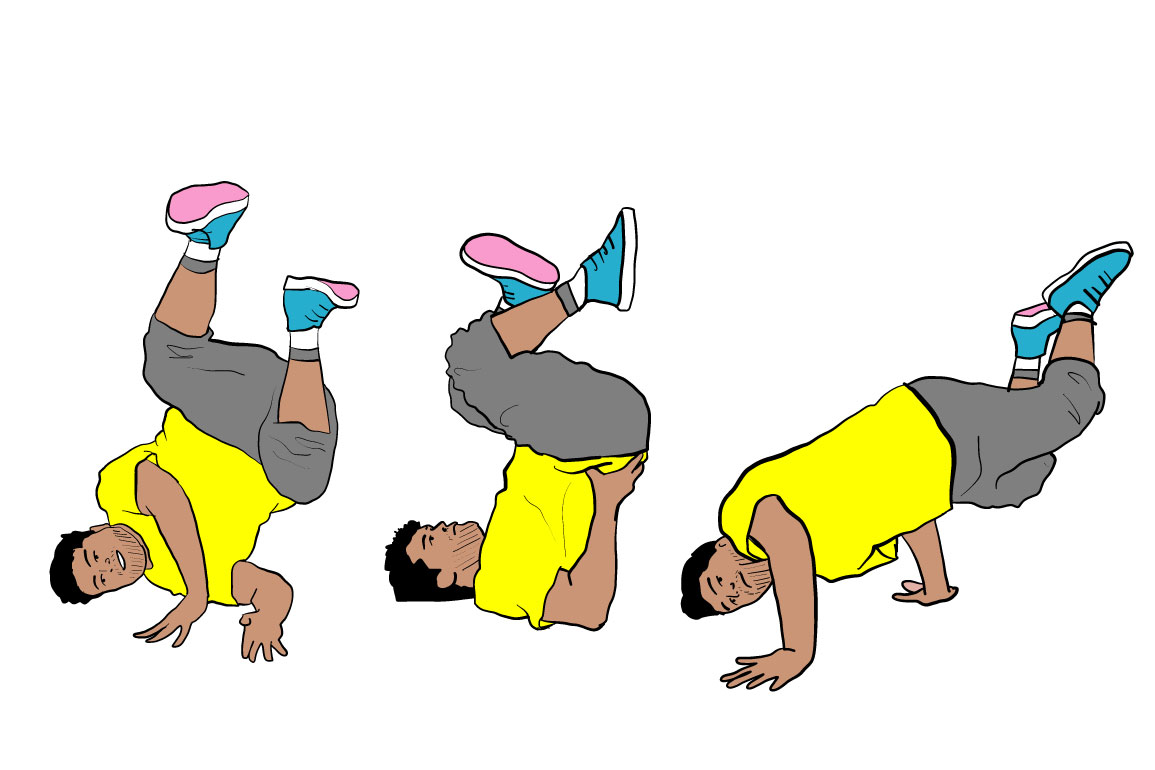
Hi everyone! Local dancer and author Chuy a.k.a. Bboy Original BEATS here. In these two pages, All The Way Up Studio co-owner Joel Sorenson a.k.a. Bboy Keitsu and I are going to teach you some core foundational elements of breaking (commonly referred to as breakdancing.*) Our goal is to give you the tools to approach your own basic set.
A set is the beginning, middle and end of your dance. If you were to dance in a circle or in a battle, your set is what happens when all eyes are on you. Following these steps in order is a good template for a beginner foundational set: tops>go down>footwork>freeze. Note that this order is not set in stone. Breaking is all about remixing things and making it your own. You could jump out with a dope freeze then transition to footwork, etc. Feel free to mix it up!
First things first…
This is a dance. A lot of folks gravitate to breaking because of the high-flying moves, but rule numero uno is that this is a dance. Even when you’re doing crazy intricate footwork or sticking a freeze, you should always try to do your movement to the music. (See sidebar for a playlist and a super-beginner intro to counts.)
*A quick note on the term “breakdancing”: To put it bluntly, breakers don’t like or use it. None of the original dancers called themselves breakdancers. It wasn’t until the ’80s explosion that the term was placed on the style by the mainstream media. Plus it’s redundant! You’re already dancing when you’re breaking. Breakdancing is like saying dance dancing.
Beats and Jams
It’s all about the music
Breaking formed in the Bronx in the early ’70s. DJ Kool Herc would throw block parties at 1520 Sedgwick Avenue, known as the birthplace of hip hop. The party people loved what they called the break of the record — the moment in a song when the drummer got down. In response, Herc created what he called “the merry go round.” He looped the break with two copies of the same record. (An example of a break is at the 2:23 mark of “Apache” in the provided playlist). B-boys and b-girls (break boys and break girls) one-upping each other on the dance floor created this dance style.
BPM means beats per minute. The first song on the above playlist has 100 BPM, with each song getting progressively faster until “Donde” at 130 BPM. Practice these moves starting with the lower BPM songs and move up the playlist as you learn.
A note on counts
Go to a dance studio and it won’t be long before you hear “five, six, seven, eight!” Truthfully, not a lot of breakers count like this. (I was years into my dance journey before someone taught me the concept.) For now, let’s think of the music in terms of kicks and snares—the boom and bap. Or, if you insist on counting, let’s break it down into a repeating one, two, three, four:

Toprock
Tops are what you do standing up. Some people (erroneously) regard toprock as what you do before you do the “actual” breaking. This is regarded as a toy mindset, and you’ll get called out if you have sloppy, off-beat or nonexistent tops. Think of your toprock as an opportunity to really show your connection with the music.
Shuffles/Hip Twists/Indian Step
One of the most foundational of the toprock steps, originally called the Indian, some call it Hip Twists. (Out of respect for my Indigenous brothers and sisters, I simply call them shuffles.)
Helpful hint: For this variation we are always switching our feet. Think of it like walking—if you are on your right foot you are going to switch to your left next, etc.

1. Swing your right foot over and to the front/left of yourself (think of it as twisting your hips to the left). Hop onto your right foot while your left foot comes up.
2. Do a micro hop back onto your left foot, lifting your right foot up while your left comes down.
3. A real subtle step. All we are doing is hopping over to our right foot.
You’re halfway there: We just completed the first half of our shuffle. Now we are set up to do the exact same thing on the other side.
REPEAT
1. Swing your left foot over and hop on it. Right foot pops up.
2. Since your right foot is up we are going to come back and down on it. Left foot comes up.
3. That subtle step again: hopping/transferring our weight back to our left foot. You just completed both “sides” of a shuffle. You are primed and ready to start right back over again with the first swing of your right foot.
A note on how to practice the rhythm. I’ve counted this step as 1&2, 3&4. Which is the natural rhythm that we want to perform this at. But if you are just learning I recommend slowing it down and trying the steps in half time, each step being right on the kick or snare: 1 2 3 4, 1 2 3 4
When you get really comfortable, try rolling through on every one-and: 1&2&3&4&. (On the faster songs you’ll be flying.)
But what about our arms!? When learning it’s easiest to focus on our feet. Once you feel like you have that down think of swinging your arms in opposition of your feet (like walking). Relax and do what feels natural.
Go Downs
A go down or a drop is our transition from tops down to the floor. A lot of newbies forget about their go downs. They think that getting down to the ground all willy nilly is good enough. You want to utilize all of your transitions in your set. Don’t get down like you’re picking something from the bottom of the grocery aisle. Make it funky.
Baseball Slide
Kids love this one. We’re just sliding on the side of our leg to a seated position.

1. Prep by crouching and putting your right hand down while your right foot steps back. I tell people to do your best superhero landing pose.
2. Sliiiide your right foot in front of you. Make sure you are sliding on the right side of your calf and be mindful of your knee!
Colt 45 (Knee Drop)
Sometimes called a knee drop or pin drop. I first heard this called a Colt 45 or Colt for short.

1. Nestle your right foot behind your left knee. You want the top of your foot in contact with the back of your knee and your toes against the left side of your knee. Make sure your right leg is turned out. (Imagine “opening” your right knee to the side.)
2. Bend your left leg and go down. You want to “fall” down diagonally, forward and to the left of yourself. Don’t think of it like buckling your knee straight in front or straight to the side; diagonal is the key. Here’s the trick: Since our right foot stayed connected and nestled up against the left knee the whole time we can go all the way down until our right foot touches the ground. When you get good at it, your left knee shouldn’t touch the ground at all.
Footwork
Footwork or downrock (usually) consists of quick, staccato steps down close to the ground. To the uninitiated, I would describe it as stepping around yourself like crabs or spiders and hitting angles on your hands and feet.
Kick Out

1. Start in a lazy crab walk position with your butt close to the ground.
2. Lean over to one side, putting your weight on one hand and raising the other. At the same time kick your feet out. You actually want to land on the back of your shoes, letting the back heel of your shoes absorb the impact.
3. Bring everything back into your original starting position. As you do so, transfer your hands to immediately go to the other side.
Try to Kick Out on both sides to the beat of the music!
Russian Taps
Most commonly referred to as CCs. B-boy Alien Ness from the Mighty Zulu Kingz made a case for why they were first called Russian Taps, and it’s a great way to learn the move. First we start with the Russian.

1. Squat down to the ground as low as you can. If your heels pop up, that’s fine. Stack one arm over the other, bending at the elbows.
2. Do your best impression of the Slavic squat dance. You know what I’m talking about. Bounce and kick one foot out then bring it in and kick the other. Back and forth.
Once you feel good and comfortable doing your Russian, let’s see if we can tap it!
3. After you kick one foot out, step over onto the foot that is in the air. (So if your right foot is up, you’re coming down onto that right foot.) The same time that you step, you turn your upper body and bring both hands down to the ground on that same side. This is the tap of our Russian Taps.
4. Come back to your Russian stance with the foot that just came down back in the air.
5. Do a Russian kick to switch to the other side. Do your tap on the other side and repeat!
Freezes
A freeze is any cool position that you can hold. Many times you’re lifting or suspending yourself up on your hands, but you can freeze on your head, elbow, shoulder — whatever you can pull off safely.

Candlestick
From your back, go up to your shoulders. If you’ve done yoga, think like starting a Plow Pose, but instead of putting your feet behind you, send them up to the sky. Keep your elbows on the ground and hold your lower back up for support.
Shoulder Freeze
Get on your hands and knees. Pick an arm and slide it under the other hand. Put the back of your arm on the ground, palm facing up. Keep going until the shoulder and side of your head are both on the floor. Tiptoe your feet closer to your center of gravity. Your goal is to stack your hips over your shoulders in balance. It helps to count down and push off to try to stick the freeze!
Baby Freeze
A tough but vital beginning freeze, as it’s the foundation for lots of other freezes and power moves. Balance your elbow on the top/front side of your hip. (For the anatomy nerds, think iliac crest.) Not too close to your belly button, but not too far to the side that it will slip. Your elbow and hip should fit like Lego bricks. Lift your feet up, but keep your other hand on the ground for stability. Tip: If it feels like you can’t get any leverage to push into the freeze, make your best frog leg impression, like you’re trying to stretch out your groin. Think frog, not turtle.
Want to learn more moves?

Visit All The Way Up Studio in North Liberty. ATWU is Iowa’s first dance studio dedicated entirely to hip hop dance. Classes range from Intro to Breaking to KPOP and Heels classes. Check out allthewayupstudio.com for a class schedule.
Chuy Renteria was raised in the town of West Liberty, IA. He graduated from the University of Iowa with a degree in Dance. A B-boy since the age of 14, he is a central figure in the Iowa dance scene. He currently resides in Iowa City and is the Public Engagement Coordinator for Hancher Auditorium. This article was originally published in Little Village issue 295.
Thoughts? Tips? A cute picture of a dog? Share them with LV » editor@littlevillagemag.com
"break" - Google News
June 08, 2021 at 12:00AM
https://ift.tt/3x3IQ8v
A beginner's guide to breaking - Little Village
"break" - Google News
https://ift.tt/3dlJq82
Bagikan Berita Ini

















0 Response to "A beginner's guide to breaking - Little Village"
Post a Comment